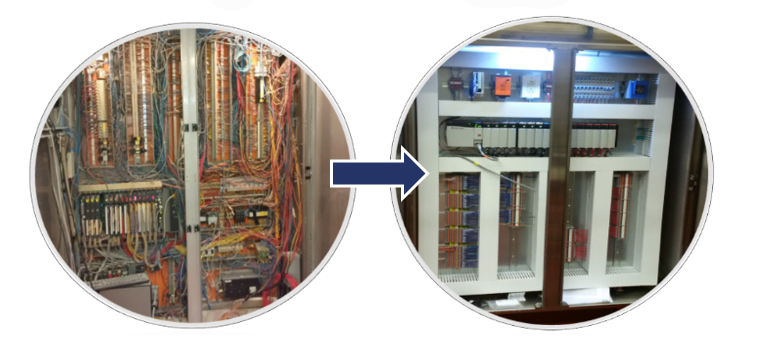
Plant Modernization
The Challenge of Old Controls in a Cheese Plant

Background:
The operations manager would suddenly see his whole process stop. That’s not good – valuable production time was lost and blended product will need to be discarded. He would call the controls guy who typically found one of two scenarios.
In scenario 1 the SCADA computers would lock up and leave them blind to the operation. The software was old and, while popular in Europe, had little support in the US. Any change was likely to lock up the whole system. This was the better scenario because the servers could be restarted fairly quickly.
In scenario 2 the PLC system would hang and refuse commands to restart. The PLCs were obsolete and used an old network protocol. The architecture was complicated with 8 PLCs, each controlling an area of the process and interlocking with each other via the communications protocol. This was a bad scenario because the only recovery was a hard restart of each PLC and that extended down time and loss of product.
Downtime was killing this plant and the whole system was so fragile that changes and additions were highly risky. In fact, their process equipment providers were declining to work in the plant due to the risk of working with the old control system. One provider stated that he tripled his bids for that plant and still lost money on those projects.
The Opportunity:
This client engaged APQ Engineering to develop a solution with the following objectives:
- Replace the PLC with a current model that is widely supported.
- Replace the SCADA with a robust and well-supported platform.
- Simplify the PLC architecture.
- Take advantage of the new system to implement process improvements.
- Integrate the new technology with minimal downtime.
The Solution:
This project was an ideal fit for APQ’s extensive experience in replacing old SCADA, converting PLCs to new models, and working with food processes.
The Rockwell Automation platform was selected because it is well supported and it is an ideal solution for this type of process.
ControlLogix was selected to replace the old PLCs. These controllers have plenty of power so only two were needed for the entire plant. This simplified the architecture and eliminated the complexity of communications and interlocks between PLCs.
ControlLogix hardware and software are well designed for scalable systems and structured migration. Studio 5000 software allows new sections of code to be merged into a running system. Point IO modules with Ethernet/IP provide a path to efficiently upgrade IO panels. Rockwell hardware and software enabled the conversion to be done section-by-section and eliminated the need for long down times.
FactoryTalk View SE was selected to replace the old SCADA system. Here are the key functions to support this type of process.
- Server based and distributed so that everyone is looking at the same data.
- Reliable and Redundant to ensure high availability.
- Locally supported and accepted by process providers.
- Historian is included to capture data for troubleshooting and improvement efforts.
Virtualized Servers are a great fit for this plant. A virtual server can be regularly backed up and very quickly restored in the event of a failure. Expensive server hardware is reduced because one physical box can power several functions. Client computers are located in a secure rack and controlled environment so they are not exposed to harsh conditions on the plant floor.
Results:
Un-planned downtime has nearly been eliminated, enabling the operations manager to focus on higher value work. Even when a problem does occur, the troubleshooting time has been greatly reduced enabling a quick return to full production.
Also, many functional improvements have been made using the improved controls. For example, programming changes resulted in shorter CIP (Clean in Place) cycles so production time was gained. The plant is adding capabilities and vendors now can easily integrate new equipment into the process.

